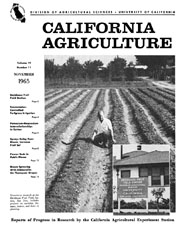


University of California
California Agriculture
|
|||
|
|||

Strawberry research at the Deciduous Fruit Field Station, San Jose, includes projects on varieties, diseases, insects, and dates of planting.
November 1965
Volume 19, Number 11 General Information |
|||
|
University of California, 1301 S. 46th St., Bldg. 478 Richmond, CA
|